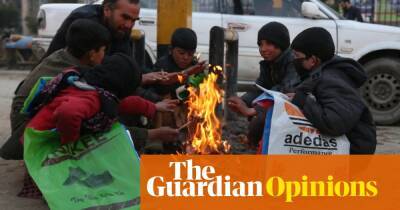Scared, hungry and cold: child workers in Kabul – picture essay
Amid the roadside restaurants and bustling crowds in one of Kabul’s busiest markets, a 10-year-old girl is trying to sell plastic bags to shoppers squeezing past her. “If I don’t work, we will go hungry,” Shaista says. Shops in the Afghan capital are stacked with food, but her family cannot afford any of it.
Each morning, Shaista buys a few shopping bags for 5 afghani (4p) each, then goes to the market to sell them for double that. As the UN predicts that 97% of Afghans could be living below the poverty line by June, the number of child labourers and beggars has tripled in Kabul, aid workers say. Many are fighting just to survive.
Shaista is shivering in her thin plastic shoes. Temperatures have dropped below zero. The smells of freshly brewed green tea and warm bread from a nearby bakery linger in the air, but – unless someone donates a meal – Shaista will not be eating until dinner. Hundreds of children – some of them as young as four – work alongside her in the big market. Others are begging, with their cold small hands stretched out as they wander through the busy crowds.
Afghanistan’s economic downfall has thrown its people into a hunger crisis. Almost 80% of the former government’s spending – including countless salaries – was foreign-funded. Aid made up 43% of Afghanistan’s GDP. When the Taliban took over the government in August, those development funds were quickly suspended.
Children working on the street warm their hands over a kebab stall’s small fire
More than $9bn (£6.6bn) of mostly private assets remain frozen in US accounts. The international community now engages carefully with the Islamic Emirate, as the Taliban regime is officially known, which is accused of killing dozens of former Afghan officials and
Read more on theguardian.com


















